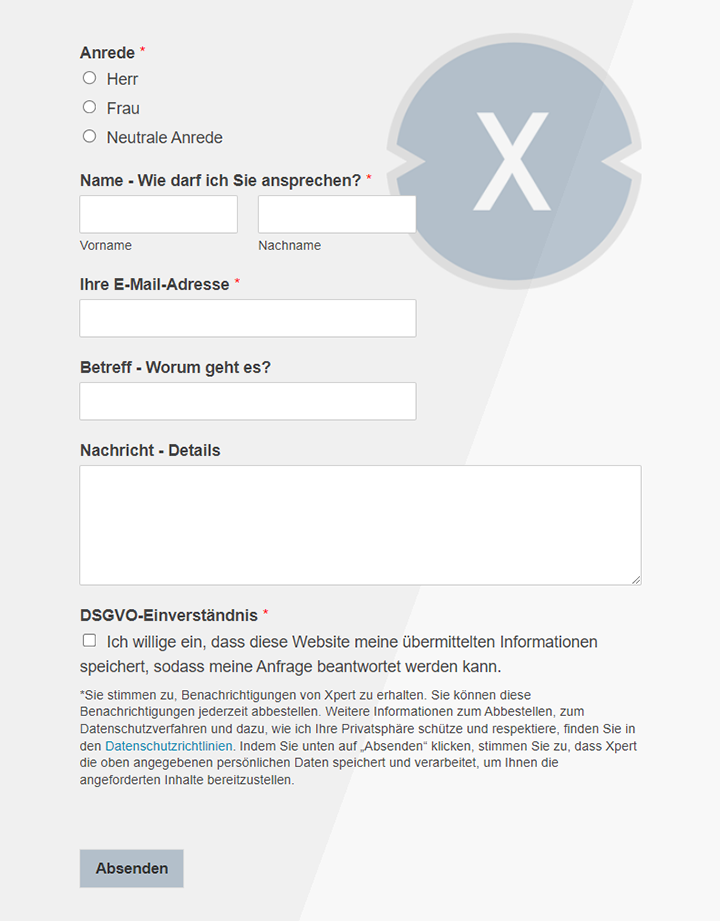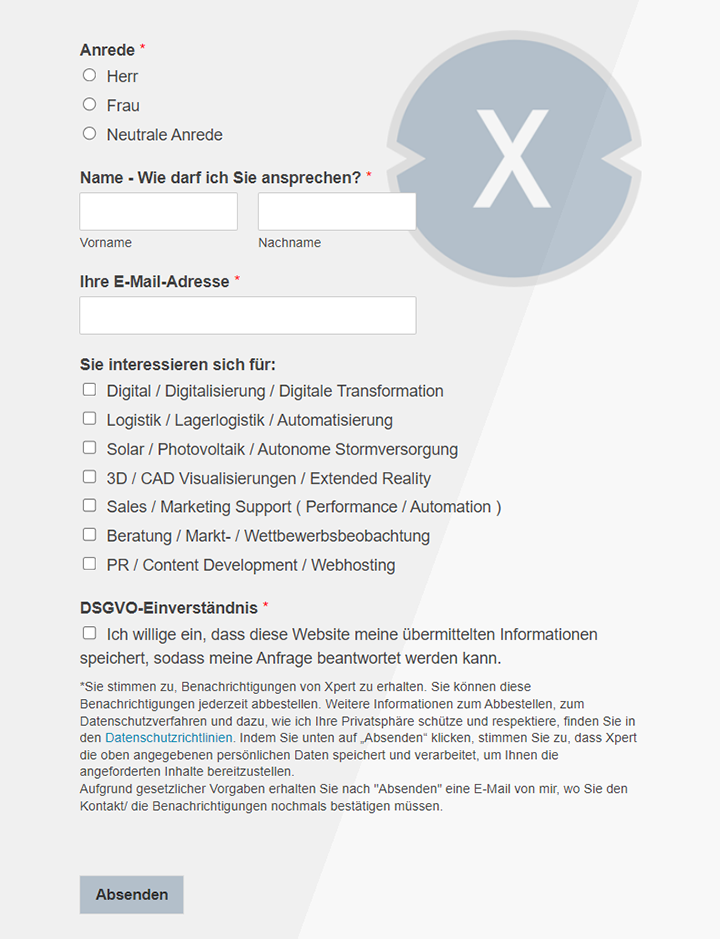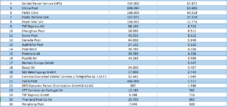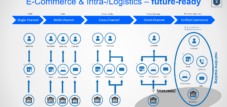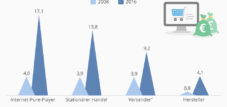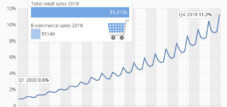Category management in comparison: online retail (e-commerce) vs. stationary retail – similarities and the 6 biggest differences
Xpert pre-release
Language selection 📢
Published on: December 28, 2024 / Update from: December 28, 2024 - Author: Konrad Wolfenstein

How do I differentiate between category management for online retail (e-commerce) and stationary retail? – Image: Xpert.Digital
How do I differentiate between category management for online retail (e-commerce) and stationary retail?
Category management in online retail (e-commerce) and in stationary retail has both similarities and important differences. Here are the key differentiators:
Basic principles
Both approaches share the same basic principles of category management:
- Shopper orientation
- Cooperative attitude between dealers and manufacturers
- Data and fact-based decisions
- Continuous optimization process
However, the implementation of these principles differs significantly in the digital and physical environments.
Product placement
Stationary trade
- Focus on physical shelf plans and spatial arrangement of products
- Limited shelf space requires careful selection of the range
E-commerce
- Virtual and dynamic product display
- Almost unlimited “shelf square” enables a wider range
- Use of product filters, search functions and personalized recommendations
Data analysis and customer behavior
Stationary trade
- Limited capabilities for real-time analysis of customer behavior
- Data is often collected through observation or customer surveys
E-commerce
- Extensive capabilities for real-time analysis of customer behavior and purchasing patterns
- Use of clickstream analysis, search behavior and personalized data
Assortment design
Stationary trade
- Limited range due to limited space
- Focus on local preferences and seasonal adjustments
E-commerce
- Possibility to offer a significantly wider range
- Easier integration of niche products and long-tail items
Customer experience
Stationary trade
- Haptic shopping experience with personal advice
- Focus on visual merchandising techniques
E-commerce
- Digital shopping experience with a focus on user experience (UX)
- Personalization through AI-powered recommendations and individualized homepages
Pricing and Promotions
Stationary trade
- Often uniform prices for all branches in a region
- Promotions through physical advertising media such as leaflets or in-store displays
E-commerce
- Ability to have dynamic and personalized pricing
- Digital promotions through newsletters, personalized offers and retargeting
Category structure
Stationary trade
- Physical departments and shelves limit the flexibility of the category structure
E-commerce
- Flexible and multi-layer category structures possible
- Easy implementation of alternative category entries such as topic-specific landing pages or brand shops
Digital flexibility or haptic experience?
While the fundamental goals of category management are similar in both areas, e-commerce requires a much more flexible and data-driven approach. The digital environment offers more opportunities for personalization and dynamic adaptation, but also places higher demands on technical implementation and data analysis. Stationary retail, on the other hand, benefits from the opportunity to create a haptic shopping experience, but has to deal with spatial restrictions.
Suitable for:
- Phygital is trending: Better customer experiences through AR and interactive displays - Why interactive technologies are changing the world of retail
- The omnipresence of touch: How touchscreen technologies are revolutionizing industries
What does category management bring me and what are the advantages?
Category management offers numerous advantages for companies and customers:
Key benefits for businesses
Increased sales and higher profitability
- Sales and market shares can be increased through optimized product range design and targeted placement of products.
- More efficient use of resources and cost savings by focusing on profitable products.
Improved customer satisfaction and retention
- The offer is specifically tailored to the needs of the target group.
- Customers can do their shopping quicker and easier through better product range structuring.
Optimized business processes
- More efficient design of purchasing, administration and warehousing.
- Shorter inventory turnover times and lower capital tie-up costs.
Better market insights
- Deeper understanding of customer behavior, market trends and competitive situation.
- Well-founded decision-making basis through data analysis.
Advantages for customers
- Better orientation and a more pleasant shopping experience through structured product presentation.
- Product range tailored to customer needs.
- Find desired products faster.
- Improved collaboration between retailers and manufacturers.
- Strengthening the competitive position through differentiated offerings.
- Possibility of image profiling for companies.
Category management enables strategic and customer-oriented control of the product range, which leads to increased efficiency, higher customer satisfaction and ultimately to increased sales and profits.
Our recommendation: 🌍 Limitless reach 🔗 Networked 🌐 Multilingual 💪 Strong sales: 💡 Authentic with strategy 🚀 Innovation meets 🧠 Intuition
At a time when a company's digital presence determines its success, the challenge is how to make this presence authentic, individual and far-reaching. Xpert.Digital offers an innovative solution that positions itself as an intersection between an industry hub, a blog and a brand ambassador. It combines the advantages of communication and sales channels in a single platform and enables publication in 18 different languages. The cooperation with partner portals and the possibility of publishing articles on Google News and a press distribution list with around 8,000 journalists and readers maximize the reach and visibility of the content. This represents an essential factor in external sales & marketing (SMarketing).
More about it here:
Digital flexibility or haptic experience?
Category management is a central building block for success in retail, whether online or stationary. However, although both areas are based on the same basic principles, they differ significantly in many aspects. In order to make these differences tangible, it is important to take a close look at both classic category management in stationary retail and the digital approach in e-commerce. The following not only explains the similarities and differences between the two approaches, but also highlights additional perspectives, trends and opportunities that go beyond the pure text framework. This article is intended to provide a comprehensive overview and illustrate how category management is evolving in the digital age.
“Category management is the key to assortment-oriented success in retail,” could be summed up in one sentence. At its core, it is based on the idea of not just looking at products based on purely economic indicators such as sales or margins, but rather of bundling them into categories that ideally correspond to the wishes and needs of customers. The focus is on focusing on the shopper, close cooperation between manufacturers and retailers and fact-based decisions. It doesn't matter whether it's a large local supermarket or a well-stocked online shop. However, these principles unfold in completely different ways in different environments.
Basic principles: similarities and differences
The guiding principle of “shopper orientation” applies to both stationary retail and online retail. This means that the range is tailored to the needs of the customer and not, as was often the case in the past, purely according to the retailer's ideas. Partnerships between retailers and manufacturers also play a major role. Joint data analyzes and an intensive exchange of information lead to synergistic advantages: “Those who know the customer best can design the range most effectively and present products in such a way that they are maximally noticed.”
A central similarity is that both approaches aim to increase sales, increase profitability and at the same time improve customer satisfaction through targeted product group management. The continuous optimization of all processes is also an important pillar in both worlds. However, there are significant differences in the concrete implementation of these principles:
- In stationary retail, shelf plans, product supports and limited space are the main challenges. In addition, data is often collected through manual processes such as customer surveys, receipt analyzes or observations.
- In online retail, however, the “digital shelf space” is almost unlimited. Product presentations can be dynamically adjusted, re-sorted and even individualized. The abundance of real-time data makes it possible to identify trends at an early stage and make personalized purchase recommendations for customers.
Product placement: spatial restrictions versus digital freedom
A key aspect of category management is the question of how goods are presented. In stationary retail you have to deal with shelf lengths, walking paths and the placement of promotional areas. Any seasonal items must be carefully fitted into the existing store layout. It is often an art to find the optimal location for bestsellers and at the same time not to overload the range. The limited shelf space means that retailers invest a lot of energy in selecting the products that are ultimately included in the range.
E-commerce shops are much more flexible in this regard. Although there is also a virtual “homepage” or certain categories, a product can appear in several categories at the same time without there being a real lack of space. Filter systems, keyword searches and product recommendations are important tools for quickly guiding customers to their desired product. “In a digital world, it is not the shelf front, but the user experience that determines the success of product placement,” one could say.
However, this freedom comes at a price: a larger online catalog often requires more maintenance. Product descriptions, images and prices must be updated regularly. It is not uncommon for hundreds of thousands of items in different versions to come together. This is where category management comes in by structuring categories, listing redundant items and pursuing a consistent brand and product range strategy.
Data analysis: Differences in depth and real time
Many data sources are used in stationary retail, such as sales figures from cash register systems and observations of customer behavior in the aisles. However, real-time analytics in-store is limited. Although modern systems record receipts immediately, the ability to analyze spontaneous purchasing impulses or detailed routes is significantly lower. Surveys, mystery shopping or video analysis can provide insights, but they usually require significantly more manual effort.
In e-commerce, tracking click and scroll behavior provides an exact picture of which products receive attention, where users drop off and which categories are particularly attractive. Online retailers can draw samples from returns, reviews and buyer profiles to continually adapt the shop. “Data is worth its weight in gold in digital category management,” it is often said in the industry. At the same time, a data protection-compliant and ethically responsible approach is also required so that the information collected is used in a legally secure manner and in the interests of the customer.
Assortment design: From lack of space to endless shelves
In stationary retail, the available space limits the range. Retailers must carefully select which items are actually worth the shelf space. Local preferences, seasonality and regional differences play a major role. A store in a city center with an upscale clientele will have different product ranges than a discount store in the country. Bestsellers are often deliberately placed at eye level, while less lucrative items end up in more distant locations.
Online retailers enjoy an almost infinite amount of “space”. It is also easy to include very specialized niche products, which promotes the long-tail effect. If you are looking for a product that is not one of the mainstream bestsellers, you are more likely to find it on the web. The online range can also be used for targeted cross-selling offers by suggesting suitable items or accessories. However, it is important that this wealth of items is structured sensibly so that the customer does not get lost in the crowd.
Customer experience: haptics versus digital interaction
A key differentiator between brick-and-mortar retail and e-commerce is the shopping experience. “The feel, the direct touch of products and the personal advice are unbeatable in stationary retail,” notes an experienced retailer. Therefore, many stores use elaborate visual merchandising techniques to present products in attractive scenarios. Decorations, lighting concepts and the opportunity to try on or try out items provide crucial added value here.
In the online shop, however, the focus is on the user experience (UX). Intuitive menu navigation, fast loading times and personalized recommendations are essential so that customers enjoy staying and shopping. Techniques such as augmented reality (AR), which place products virtually within one's own four walls, or 360-degree views of items are being used more and more frequently. This can at least partially replace the missing feel. However, this requires high investments in technical implementation and continuous optimization in order to keep pace.
Pricing and Promotions: Consistent or Dynamic?
When it comes to price promotions, stationary retailers often take a conservative approach. “Uniform prices for all branches in a region” are not uncommon. Promotions are communicated via flyers, posters or in-store displays. The success of a campaign is assessed with a time lag.
The situation is different for online retailers: They have the option of dynamic, sometimes personalized pricing. Price changes can occur in real time depending on factors such as demand, competitive activity or even individual user profiles. Newsletters, targeted online advertising and retargeting make it possible to re-engage customers after they have already left the shop. This enables efficient and close control of promotions.
Category structure: Fixed departments versus flexible online categories
In retail stores, the category structure is often based on the architecture of the store. “The shelves are static, you can only convert them to a limited extent,” says an experienced category manager. The result is a system of departments or product groups that can only be changed slowly and with high conversion costs.
Category structures can be designed flexibly online. Categories can be added, deleted or moved without requiring any structural work. In addition, a multi-layered structure can be realized in which products appear in several categories at the same time. It is also possible to create topic-specific landing pages, for example for seasonal promotions (“summer hits”, “Christmas offers”, etc.), or to set up exclusive brand shops that offer the customer a uniform brand experience. This creates the basis for a highly variable shopping experience in which the customer can choose his own path.
Digital flexibility or haptic experience?
E-commerce impresses with its flexibility and data-driven methods. However, he has to forego the haptic moment that only stationary retail can offer. Online retailers are relying even more on AI-supported personalization and interfaces that enhance the shopping experience. For many companies, the future lies in a hybrid form, “Phygital”, i.e. the fusion of physical and digital trade. Technologies such as interactive displays, augmented reality or contactless payment systems are used here. “Phygital is trending: Better customer experiences through AR and interactive displays – Why interactive technologies are changing the world of retail,” it says with a view to the future. The idea of “omnipresence of touch” also plays a role here: touchscreen technologies are revolutionizing industries by being used both on shelves and in smartphone displays.
Anyone who gets involved in this symbiosis can meet the customer at several points. Brick-and-mortar stores offer the opportunity to experience products, while digital channels provide extensive information and enable an ongoing relationship with the customer. A seamless transition between online and offline – the omnichannel principle – ensures long-term competitive advantages.
What does category management bring me and what are the advantages?
Category management contributes greatly to increasing competitiveness. Anyone who manages their product range strategically and aligns it with the actual needs of customers increases their chances of asserting themselves in the market. The advantages are noticeable for both companies and customers.
Key benefits for businesses
1. Increased sales and higher profitability
Sales and market shares can be increased through optimized product range design and targeted product placement. “Retailers who have their categories under control increase the chance that customers will find exactly what they are looking for – and more.” Better distribution of resources also leads to cost savings and thus to a higher margin.
2. Improved customer satisfaction and retention
By focusing on customers' real needs and preferences, the shopping experience becomes more enjoyable. A clear category structure and intuitive navigation help customers find their way around quickly. This results in higher repeat purchase rates and long-term customer relationships.
3. Optimized business processes
Category management also intervenes in procurement, warehousing and administration processes. By knowing which items are selling and how well, supply chains can be better planned and inventory levels can be optimized. This has a positive effect on turnover times and reduces capital tie-up costs.
4. Better market insights
By focusing on categories, companies gain detailed insights into market trends, competition and customer behavior. This enables well-founded, data-based decisions.
Advantages for customers
Better orientation
A clear product presentation makes it easier to find the desired products. “Customers are grateful when they get exactly what they need in their category – without having to search for a long time,” confirm many retailers.
Offer tailored to customer needs
If you define your categories correctly, you can tailor the range exactly to the wishes of the target group. This makes customers feel understood and makes them more likely to return.
Faster shopping experience
Whether offline or online: A logical category structure and well-thought-out placement enable quick purchasing. After all, time is an important factor in many people's everyday lives.
Increased satisfaction
If the purchase goes smoothly and pleasantly, satisfaction also increases. A positive shopping experience promotes customer loyalty and ensures that the company is recommended to others.
Holistic benefits through strategic category management
Category management is more than just a question of shelf organization or product selection. It is a strategic approach that influences the entire business model - from procurement to pricing to customer communication. Especially in the digital area, it offers a variety of new opportunities to collect data and precisely address customer needs. Online it is easier to increase product range depth, integrate niche products and operate flexible pricing.
At the same time, the value of stationary retail should not be underestimated. The personal shopping experience and the opportunity to see products up close are strong advantages. By cleverly interlinking both worlds, the respective strengths can be used optimally. “Phygital” strategies, in which stationary stores and online shops are cleverly combined, are redesigning the shopping experience: Digital tools provide information about products while at the same time allowing you to try them out on site. Those who seize these opportunities and consistently pursue holistic category management will be ahead in the long term.
Overall, it shows that category management is a powerful tool for being successful in both traditional retail and e-commerce. The fundamental principles – shopper orientation, cooperation with manufacturers, data-supported work and permanent optimization – remain important. But the practical implementation must be adapted to the respective circumstances. Brick-and-mortar retailers should focus more on the experience component and efficient use of space, while online retailers should primarily leverage the advantages of their extensive data.
Anyone who masters the balancing act between haptic experience and digital dynamics can assert themselves in the highly competitive market and retain their customers in the long term. Category management serves as a compass that enables companies to not only satisfy their target group, but to inspire them.
Category management thus lays the foundation for a future-proof, customer-oriented retail strategy that meets the ever-growing requirements in e-commerce as well as the ongoing needs for a real shopping experience in stationary retail.
We are there for you - advice - planning - implementation - project management
☑️ SME support in strategy, consulting, planning and implementation
☑️ Creation or realignment of the digital strategy and digitalization
☑️ Expansion and optimization of international sales processes
☑️ Global & Digital B2B trading platforms
☑️ Pioneer Business Development
I would be happy to serve as your personal advisor.
You can contact me by filling out the contact form below or simply call me on +49 89 89 674 804 (Munich) .
I'm looking forward to our joint project.
Xpert.Digital - Konrad Wolfenstein
Xpert.Digital is a hub for industry with a focus on digitalization, mechanical engineering, logistics/intralogistics and photovoltaics.
With our 360° business development solution, we support well-known companies from new business to after sales.
Market intelligence, smarketing, marketing automation, content development, PR, mail campaigns, personalized social media and lead nurturing are part of our digital tools.
You can find out more at: www.xpert.digital - www.xpert.solar - www.xpert.plus





